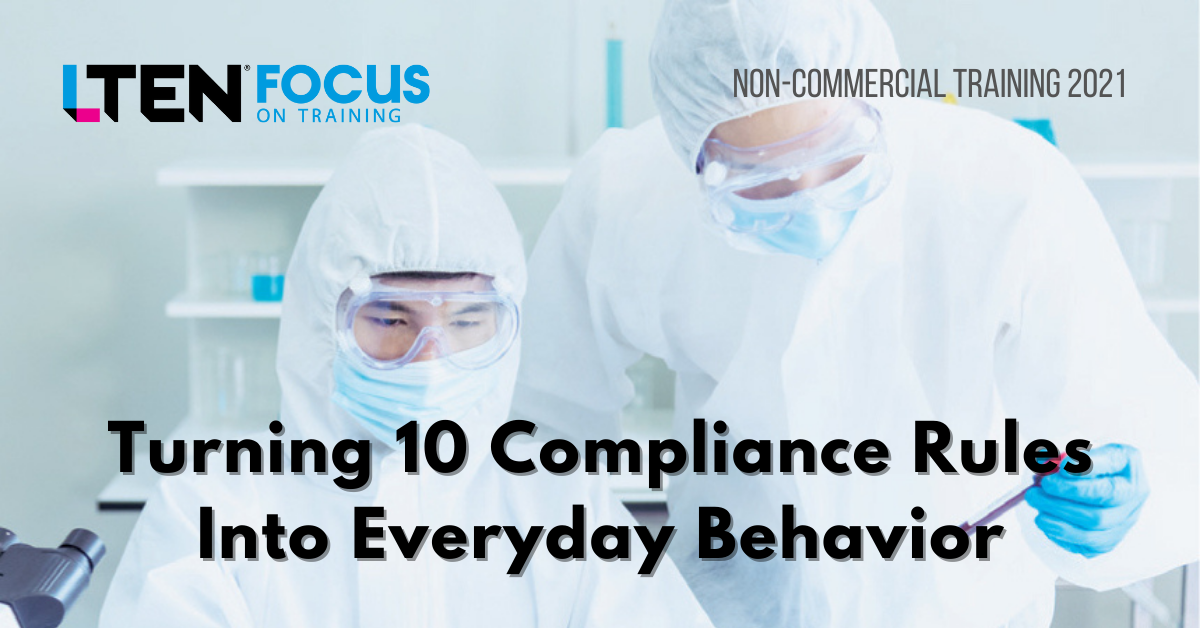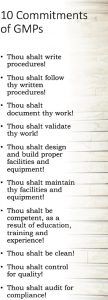
Turning 10 Compliance Rules Into Everyday Behavior
Feature Story – By Vivian Bringslimark
Just reciting the rules doesn’t make compliance happen
Way back when, the core content of every Good Manufacturing Practice (GMP) Basics course was the 10 rules to follow. Within the compliance training network, these 10 rules became known as the “10 Commandments of GMPs.”
 To condense the 21 CFR 211 regulations for new hires, the idea was to focus on just these 10 rules. A quick review provides a decent overview of the subparts and the expectations for adhering to them. This was, after all, the 1980s and we’ve learned a lot since then.
To condense the 21 CFR 211 regulations for new hires, the idea was to focus on just these 10 rules. A quick review provides a decent overview of the subparts and the expectations for adhering to them. This was, after all, the 1980s and we’ve learned a lot since then.
The hardest lesson we’ve had to learn as an industry may be that telling the GMPs doesn’t automatically make compliance happen. When you re-examine these 10 rules from a new hire’s perspective or even legacy employees’ experience (meaning organizational actions speak louder than words), it becomes a tall order to tell, lecture, preach or scold our folks into complying with the rules without breaking them down into memorable and meaningful commitments.
For many employees, these rules are theoretical, abstract and conceptual, but not practical. It may not be easy for them to put into practice on their own without the help of trainers, supervisors, managers and leaders connecting the content to their workspace, to their everyday work routines.
In essence, we are expecting the GMP rules to become an everyday routine automatically without reinforcement post-training. It’s supposed to become part of “what we do around here,” and not meeting these expectations is not acceptable, not even to peers.
Well, it’s 2021 and many of us in the compliance training space are still on that journey to take the regulations (theory) and help put them into practice. What we are learning is that the rules need to translate into tangible and observable behaviors that make sense to our employees so that they can emulate them to meet the compliance expectations.
Reworking the 10 Rules to Compliance Work Habits
It’s not that 10 rules are too many to remember. It’s about relevancy and applicability to everyone. For example, the first rule, “thou shalt write procedures,” does not apply to everyone, but the second rule, “thou shalt follow thy procedures,” does.
This is one of the reasons why the one-size-fits-all style of GxP refreshers is not working. Many walk away from the sessions thinking, “That doesn’t apply to me, why was I required to attend?” When the “one and done” content dump is used for GxP training, employees are not provided with a forum to develop critical thinking skills or allowed to practice solving issues with a compliance focus.
Then What Can Be Done?
 We narrow the focus to what applies to all regardless of assigned functions and take a deeper dive into their work environment. We design sessions that provide practical takeaway messages with compliance behaviors that they can do back on the job because of the learning experiences within the training sessions.
We narrow the focus to what applies to all regardless of assigned functions and take a deeper dive into their work environment. We design sessions that provide practical takeaway messages with compliance behaviors that they can do back on the job because of the learning experiences within the training sessions.
The challenge lies in describing the compliance behaviors, and requiring our folks to adopt them by putting them into daily practice so they become work habits. We must provide opportunities to show them what that looks like. We can’t do that by just telling them or lecturing to them on how it’s done.
We must facilitate their learning experiences by allowing them to engage in interactive exercises and small group activities with their colleagues. It raises their level of participation to actively being involved with the content and being able to put it to use after the session is over. It gives them responsibility for their own learning.
By listening to a diverse group of colleagues during the exercises and activities, employees also get a glimpse into others’ “workworld.” It helps them visualize how the regulations are being put into practice. This in turn sparks similar behavior and sometimes opens the path for effective improvement discussions after the sessions.
One Size Only, Not Delivered Here
A pharmaceutical company committed to the FDA that they would overhaul their GMP training program. To reset the baseline, a comprehensive basics course was designed. However, the delivery of the lessons was then tailored for five distinct classifications of roles and functions.
For the GMP work habits portion of the course, folks were asked, “Which of the work habits do you think is the hardest to achieve for your work area?” Their responses were captured on a flipchart and tallied. The habit that received the most votes was chosen. In case of a tie or close second, the class was spilt into two groups.
Their next task was to identify the barriers that were getting in the way or could get in the way within the next few weeks. Then they were asked to vote on their biggest barrier. The top three were identified and later shared with site leadership. When time permitted, the last task challenged them to generate ideas on how to overcome the biggest barrier.
This problem-solving format stimulated lively discussions. They stayed focused and were motivated to learn more about the identified work habit. It was also a great opportunity to promote critical thinking and to initiate the anticipated transfer back to work.
Debriefings Are the Key to Experiential Learning
The key skill of an experiential learning facilitator is to ask questions that guide learners to connect regulations content to the learning objectives and how to apply it back on the job immediately after. Consider a set of three debriefs to help connect all the dots:
- Debrief One is feedback on the activity. Check to see what they got right, wrong or interpreted differently than expected. You may be surprised by alternative responses, some good and some concerning.
- Debrief Two is feedback about the activity itself. Get them to talk about what happened in their group, was the activity helpful, how did they feel.
- Debrief Three is the real learning. This is where they are asked to reflect on their insights and how they can use them for their work and when.
It’s Time for Your Debrief
We can skip Debrief One because you weren’t assigned an activity to complete. But we can agree that reading this piece was your task. Was it worth your time? Was it of any value for you? Did it invoke any feelings, positive or negative?
And finally, do you have any new insights? What might you do with those insights? Will you act on them? What compliance behaviors are you expecting your employees to perform correctly? Are you merely telling them, or are you providing opportunities for them to see them in action, not just the deviation examples?
Vivian Bringslimark is a principle with HPIS Consulting and a member of the LTEN Non-Commercial Training Committee. Email Vivian at vivianbring@comcast.net.








